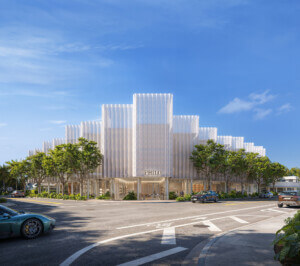London-based research collective Forensic Architecture, known for its use of architectural, spatial, and technological analysis to uncover state and corporate violence, opens its first major U.S. exhibition today at Miami Dade College’s Museum of Art and Design (MOAD).
However, as the collective’s founder, Eyal Weizman was preparing to fly to Miami from his home of London for the opening, he received an email from the U.S. Embassy informing him that his visa had been revoked and he would not be allowed to travel to the United States.
When Weizman went to apply for another visa, an interviewer at the Embassy told him that an “algorithm” had identified him as a security threat due to people he had interacted with, places he had traveled recently, or an unidentified combination of the two. When given the opportunity to “speed up the process” by giving names he felt might have been the cause for setting off alarms, Weizman refused.
Here is the full statement, which will be read by his partner professor Ines Weizman at the MOAD tonight, and was sent to AN by Weizman via email.
Today (February 19th) I was meant to be here with you at the Museum of Art and Design in Miami to open Forensic Architecture’s first major survey exhibition in the United States, True to Scale.
But on Wednesday, February 12th, two days before my scheduled flight to the U.S, I was informed in an email from the U.S. Embassy that my visa-waiver (ESTA) had been revoked and that I was not authorised to travel to the United States. The revocation notice stated no reason and the situation gave me no opportunity to appeal or to arrange for an alternative visa that would allow me be here.
It was also a family trip. My wife Prof. Ines Weizman, who was scheduled to give talks in the U.S. herself, and our two children traveled a day before I was supposed to go. They were stopped at JFK airport in New York where Ines was separated from our children and interrogated by immigration officials for two and a half hours before being allowed entry.
The following day I went to the U.S. Embassy in London to apply for a visa. In my interview the officer informed me that my authorization to travel had been revoked because the “algorithm” had identified a security threat. He said he did not know what had triggered the algorithm but suggested that it could be something I was involved in, people I am or was in contact with, places to which I had traveled (had I recently been in Syria, Iran, Iraq, Yemen, or Somalia or met their nationals?), hotels at which I stayed, or a certain pattern of relations among these things. I was asked to supply the Embassy with additional information, including fifteen years of travel history, in particular where I had gone and who had paid for it. The officer said that Homeland Security’s investigators could assess my case more promptly if I supplied the names of anyone in my network whom I believed might have triggered the algorithm. I declined to provide this information.
This much we know: we are being electronically monitored for a set of connections—the network of associations, people, places, calls, and transactions—that make up our lives. Such network analysis poses many problems, some of which are well known. Working in human rights means being in contact with vulnerable communities, activists and experts, and being entrusted with sensitive information. These networks are the lifeline of any investigative work. I am alarmed that relations among our colleagues, stakeholders, and staff are being targeted by the U.S. government as security threats.
This incident exemplifies—albeit in a far less intense manner and at a much less drastic scale—critical aspects of the “arbitrary logic of the border” that our exhibition seeks to expose. The racialized violations of the rights of migrants at the U.S. southern border are of course much more serious and brutal than the procedural difficulties a U.K. national may experience, and these migrants have very limited avenues for accountability when contesting the violence of the U.S. border.
As I would have announced in today’s lecture, this exhibition is an occasion to launch a joint investigation with local groups into human rights violations in the Homestead detention center in Florida, not far from here, where migrant children have been held in what activists describe as “regimented, austere and inhumane conditions”.
In our practice, exhibitions are treated as alternative forums for accountability, ways of informing the public about serious human rights violations. Importantly, they are also opportunities to share with local activists and community groups the methods and techniques we have assembled over years of work in the field.
To that effect, this exhibition includes an investigation into a CIA drone strike in Pakistan that was presented by a UN Special Rapporteur in the General Assembly; an analysis of the Chicago police killing of a barber that lead to an investigation by the mayor and the city’s police department; and an inquiry into the Israeli bombing of Rafah in Gaza that informed the International Criminal Court’s recent decision to open an investigation into the possibility of Israeli war crimes in occupied Palestine—all alongside other investigations we have conducted with communities and human rights collaborators in Germany, Venezuela, the Mediterranean, and Syria.
These works seek to demonstrate that we can invert the forensic gaze and turn it against the actors—police, militaries, secret services, border agencies—that usually seek to monopolise information. But in employing the counter-forensic gaze one is also exposed to higher level monitoring by the very state agencies investigated.
I would like to thank all those who showed enormous commitment to make this exhibition possible, especially Sophie Landres, Francisco Canestri, Gladys Hernando, Nicole Martinez and Rina Carvajal from MOAD, members of Forensic Architecture here and there, friends who helped through this process, Ines for reading this statement, and you all for coming.
Mostly though I would like to thank our partner communities who continue to resist violent state and corporate practices and who are increasingly exposed to the regime of “security algorithms”—a form of governance that aims to map, monitor, and—all too often—police their movements and their struggles for safety and justice.











